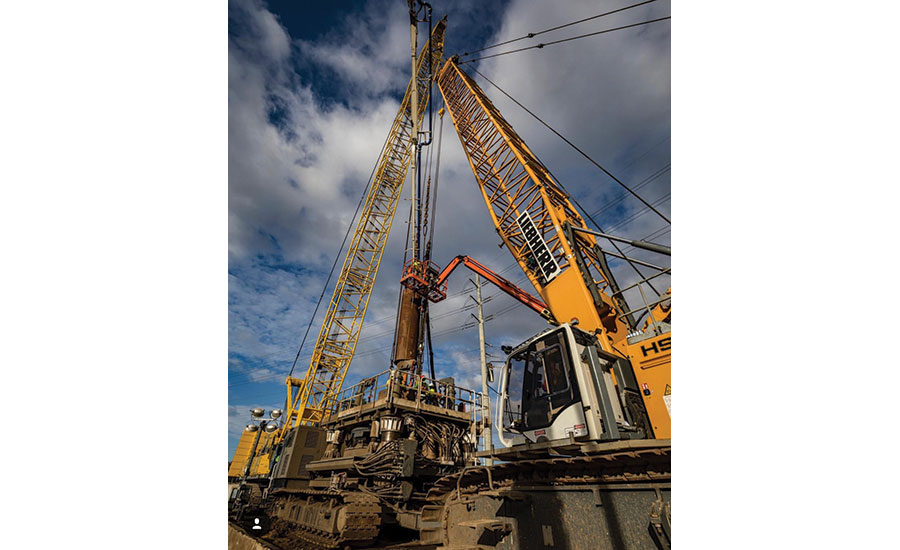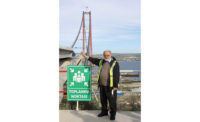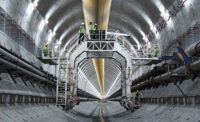Crews Install Record-Setting CIDH Pile 332 Ft Deep

Crews installed a 10-ft-dia cast-in-drilled-hole pile 332 ft deep, in what officials believe is an industry record.
PHOTO COURTESY OF STG
Working on a customized trestle in the middle of a stream, crews recently installed in Oahu, Hawaii, what officials say may be the deepest 10-ft-dia cast-in-drilled-hole pile (CIDH) in foundation history.
A design-build joint venture team of Shimmick/Traylor/Granite, working since 2017 on an $875-million contract to build 5.2 miles of elevated light rail, began installation in late May of a 357-ft-long pile down to 332 ft deep. It is one of 225 CIDH piles required for the project, slated for completion in 2021 as part of an overall 20-mile, $8-billion system.
Legacy Foundations, a division of Shimmick, an AECOM company, installed 572,800 lb of working casing to the bottom of Shaft 629 using a 3.6-m oscillator. Crews removed 1,000 cu yd of mostly clay and other unstable material.
The 340-ft reinforcement cage, weighing 195,000 lb, was built in six sections that were spliced together over the excavated pile and lowered in. A tremie pipe 365 ft long placed roughly 900 cu yd of concrete in five hours.
Overall, shafts range from 20 ft to 357 ft, says Rusty Lucido, vice president of Legacy Foundations. “The reason why is variance in soil conditions,” he says. “Sometimes you have really hard rock, lava rock. Other times it’s soft mush, and that’s the case for these shafts.” The piers must support a future station.
Crews worked nonstop to place the concrete through the first week of June. “Once you go that deep, you have to continuously work because of the earth conditions—otherwise it would lock up and freeze the casing skin,” says Lucido. “You can’t stop turning. Once committed, we had to finish and get that shaft done.”
Although the Kahili Strait is only about 10 ft deep, the pile had to go through marshy soils built up over time to some 300 ft, notes Lucido.
A temporary trestle had to be built for pile-driving both there and at Moanalua Stream, says Pirooz Barar, principal engineer with PB&A Inc., the trestle designer. “The oscillator exerted up to 14,000 kip-ft of torque to install the casings.” he says. “This torque was created by an equivalent 600 kips of lateral load and yet the trestle couldn’t move more than two inches.”
Reaction piles were integrated into the trestle at each pier location to provide adequate lateral support for the oscillator. The firm developed a methodology to measure soil stiffness, clay velocity and ultimately to model reaction piles and calculate lateral deflection.
Lucido adds that the trestle had to bear the force of 1 million lb from the oscillator plus the dead weight of about 400,000 lb total of equipment.
The five-mile line will connect riders between Aloha Stadium and the Honolulu airport, with four stations. Typically, airport-related traffic is about 30,000 people a day, but with traffic now less than 1,000 a day because of the pandemic, “the airport allowed us to relax maintenance of traffic [restrictions],” says John Moore, east area construction manager with the Honolulu Authority for Rapid Transportation (HART). “It used to be that for night work, we couldn’t shut down until 8:30 p.m.; now they can start at 3 p.m.,” he says. “It facilitated the ability to get crucial piers in place sooner than anticipated.”
To place the precast concrete girders, crews are utilizing two articulated gantry cranes that can go around tight curves, thus eliminating falsework, says Moore. Those cranes and a regular gantry are placing 212 spans, each about 145 ft and consisting of 12 segments. The 2,700-plus match-cast segments are cast in a yard 15 miles from the site, says Dan Howell, the joint venture’s project director. The guideway, with columns as high as 70 ft, will pass as close to 6 ft from structures including an airport parking garage and a freeway.
The two 456-ft-long gantries, built by Deal, were designed in Italy, with components built in Germany and China, Howell notes. That created a time zone challenge in coordination.
Although the overall program has experienced plenty of financial and legal challenges, Moore says this contract is going well, with less than $12 million in negotiated, bilateral change orders.
Bids are due July 23 for the last four-mile portion of the 20-mile program, for a public-private partnership that will include 30 years of operations and maintenance, says Moore.




